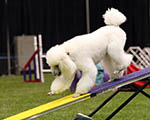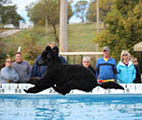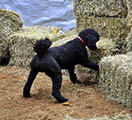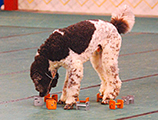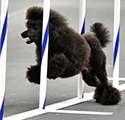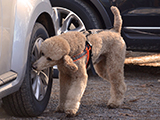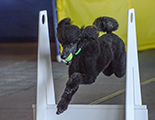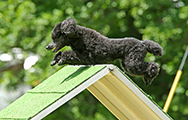Crates: Their Purpose and Use
Dogs are natural den animals. They prefer a quiet, confined, enclosed area where they feel safe and secure. Views on crating dogs have changed for the better over the years; however, some people still think of crating as “caging” their dog. In fact, the proper use of a crate can help in housetraining, provide secure travel, lower the stress in a dog, keep a dog safe in certain environments, and keep him from damaging his surroundings.
TYPES OF CRATES
Crates can be made of wire, molded plastic, metal, wood or materials similar to heavy fabric.
Wire crates vary from heavy gauge to lighter weight types which fold and store easily. Wire crates allow total ventilation and enable the dog to see everything in his environment. That visual stimulation may be too much for some dogs. In this case, the wire crate can be covered with a sheet, thus producing the “den” effect. Some dogs may pull or chew on the sheet covering the crate. To avoid this, place a piece of thin plywood on top of the crate. The plywood should be large enough to allow the sheet to hang a distance from the crate where the dog cannot gain access to the sheet.
Plastic or metal airline crates are required to ship a dog by air. Most airlines have specific crate requirements for canine shipping, so consult with your airline carrier. An airline-approved crate also offers greater protection to the dog in an accident. Plastic airline crates separate into two halves which can be stacked for storage. They are also safer for small dogs or puppies as there is less chance of a leg, paw or jaw getting caught in the wire.
Fabric or soft-sided crates are light weight, fold easily, and are convenient when traveling. A dog must be completely crate trained before you can trust him in a soft-sided crate, because the crate can be chewed through or rolled and moved. For these reasons a soft-sided crate is not recommended for puppies.
WHERE CAN I BUY A CRATE?
New crates can be bought in pet shops and discount pet food outlets, from pet catalogs, at dog shows, farm supply stores, department stores, or on the Internet. Used crates can often be found at garage sales and on the Internet on Craig’s List. Be prepared to thoroughly clean and disinfect a previously-owned crate before using it. The price will depend on the size, manufacturer and type. Many come with a removable floor. Some can be ordered with doors on the side or the end, or both. Various kinds of crate pads are available to cushion the bottom of the crate. Most crate pads are washable.
HOW DO YOU CRATE TRAIN A POODLE PUPPY OR ADULT?
Most dogs are very accepting of a crate. Any complaining at first from a puppy is more likely due to adjusting to his new environment and perhaps the loss of his littermates. Place the crate in a room the family uses, such as the kitchen. Keep it out of drafts and away from any blowing hot or cold air vents. Start by feeding the Poodle in the crate. This will make the crate a positive place and enable him to eat without any interference from other dogs or children in the house. Establish a routine. Put him in the crate for naps, when he must be left alone for a few hours, or whenever a responsible person is unable to supervise him. Be sure to remove a collar with tags as it might become caught in an opening or wire grates. Always use a cheery tone of voice and a command such as “go kennel” or “go to bed” when placing or sending a dog to his kennel, tossing in a treat for a reward.
HOUSETRAINING USING THE CRATE
Many people prefer to immediately teach a puppy to only eliminate outside, rising early in the morning when he wakes up. Most healthy puppies learn to sleep through the night within a few weeks. Large puppies such as a Standard Poodle can be clean through the night as early as 8 weeks. Smaller puppies may take a bit longer. The length of time it takes to be clean through the night is dependent on the routine the Poodle had previously, the size and maturity of the dog’s bladder, and the last time food and water were given to him.
Housebreaking can be achieved more quickly if the owner is consistent about using a crate routine. Keep the pup crated for as long as it can hold it, then take the puppy straight outside, giving ample opportunity for the pup to relieve himself. Give the puppy a lot of praise when he eliminates and then take him back inside for at least 15 minutes of free time before going back in the crate. The idea is to build up the amount of time the pup is able to both hold it and remain free in the house by gradually giving the pup longer periods of free time inside the house, then crating for a period of time before letting him back outside.
If you find your puppy is soiling the crate pads, towels or blankets in the crate, remove them and keep the bottom clear of any bedding. Some puppies will soil in their crate and hide it in their bedding. If there is no padding, the puppy must sit in his waste. Most puppies will want to avoid this and will “hold it” longer. Some puppies are used to eliminating on newspaper, so the use of paper to line the bottom of a crate is not recommended.
WHAT SIZE CRATE SHOULD I BUY?
All crates should be large enough to permit the animal to stretch out flat on his side, stand up and turn around. If you do not know the approximate adult size of your puppy, buy the larger size. For an adult dog, use a crate close to his length, measuring from the tip of his nose to the base of the tail. The height and width of the crate will be proportionate to the length. Many wire crates have a larger ‘footprint’ in proportion to height than the plastic airline crates.
A temporary crate is most convenient for a puppy. Look for a used one. If you must use an adult size crate, make it smaller by placing a large plastic box in the back or making a moveable partition out of wire or wood. Make sure whatever you use is safe and secure if the puppy chews on it. If the crate is too large it is not as effective a tool for housetraining, because the puppy can move away from where he has eliminated.
WHAT DO I DO IF MY POODLE DOES NOT LIKE THE CRATE?
There are very few dogs that will not accept confinement. While more common with adult dogs than puppies, there are a few which seem to show signs of claustrophobia when crated. Before giving up, try a different kind of crate. If, despite every effort to use positive methods, the dog is obviously frantic or panicked, it is inhumane to continue its use. These dogs can do physical damage to themselves trying to escape. It is always worth trying, however. In most cases, use of a crate will prevent or solve undesirable behaviors, enhancing the relationship you have with your dog.
WHEN IS USE OF A CRATE APPROPRIATE?
A dog crate is not recommended as a method of confinement for a dog regularly left alone all day, although some dogs may learn to tolerate it. If necessary on a temporary basis, the dog must be well exercised before and after crating. Additionally, he will need extensive personal attention when you are home and freedom during the night rather than being crated again at bedtime. It is also very important that the crate is large enough so he can stand erect and stretch out fully on his side. An oversized crate is recommended. It must also have a non-spill water dish. Ideally, someone will come during the day to provide a time for elimination and exercise. An exercise pen (x-pen) can be attached to the front of each side of a crate, allowing the dog or puppy more room to move about while still being confined and providing a space outside the crate for him to eliminate.
For puppies, a crate can be used as a playpen for general confinement. It should be large enough for a sleeping space with bedding at one end and a papered area for elimination at the other. Again, a water dish must be provided.
Be aware that a puppy raised in isolation may suffer from lack of socialization, leading to difficulties in training, housetraining, and poor social skills with other people and dogs. Dogs are social creatures, and a puppy that lacks sufficient human contact will grow up to be a poorly-adjusted dog and pet.
WHAT ARE THE ADVANTAGES FOR ME OF USING A CRATE?
- You can leave your dog home alone, knowing he will not damage your belongings. He is protected, comfortable, and unable to get into trouble.
- Housetraining is easier as the close confinement encourages cleanliness and control. You can establish a regular routine for your dog and prevent accidents in the house.
- You can keep the dog from being underfoot or in the way during meals, prevent him from wandering outside when people might leave outside doors open, or when he becomes over-stimulated and needs time to calm down.
- You can travel with your dog knowing that he cannot get loose in the car or escape if a door is open and that he cannot distract the He is safely confined for his protection in an accident, and he has the comfort of familiar surroundings when away from home.
- If you plan to show your dog in performance venues such as agility or obedience, it is essential that the dog be crate trained. Your dog needs a quiet place to relax while at the show.
- Using a crate as a “time out” when a dog is over stimulated and misbehaves gives the dog time to calm down. “Time outs” should be done without any negative emotion from you. Simply lead the dog to the crate, put him in, and close the door.
WHAT ARE THE ADVANTAGES FOR MY POODLE OF USING A CRATE?
- He has his own space, a den, where he can retire when tired, stressed, or needing to escape too much attention from children in the household.
- He can avoid the consequences of undesirable behaviors that have been prevented.
- He can more easily learn to control his bodily functions.
- He can remain in proximity to the family when supervision is impossible instead of being banished to the garage or yard.
- He can be included in family outings and trips rather than being left home or at a boarding kennel.
- Feeling secure in a crate will lessen his anxiety when he has to be crated at the vet or groomer.
- Accustoming your dog to a crate makes shipping the dog much less stressful.
You want a well-mannered pet, and your dog wants to please you. A dog crate can accomplish this for you both. Additionally, the cost of a crate is minor compared to the expense of replacing furniture, carpeting, or veterinary bills from your dog eating inappropriate and harmful objects.
The information contained in these documents is current at the time of this writing and is accurate to the best of VIP’s knowledge.
This information has been provided to you at no charge. You are free to use it provided it is used in its entirety with no changes or alterations and that the copyright remains intact. If you have found this information to be helpful, please consider making a tax-deductible donation to:
Versatility in Poodles
4061 Highlands Rd
Franklin, NC 28734
To make a donation via PayPal, please click the Donate Button:
![]()
The contents of the www.vipoodle.org website, such as text, graphics, images, and other material contained on this site (“Content”) are for informational purposes only. The Content is not intended to be a substitute for professional veterinarian advice, diagnosis, or treatment. Always seek the advice of your veterinarian with any questions you may have regarding the medical condition of your pet. Never disregard professional advice or delay in seeking it because of something you have read on this website!
If you think your pet has a medical emergency, call or visit your veterinarian or your local veterinary emergency hospital immediately. Versatility in Poodles and www.vipoodle.org do not recommend or endorse any specific veterinarians, products, procedures, opinions, or other information that may be mentioned on this website. Reliance on any information appearing on this website is entirely at your own risk.



